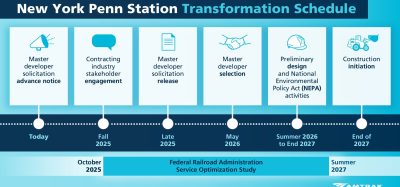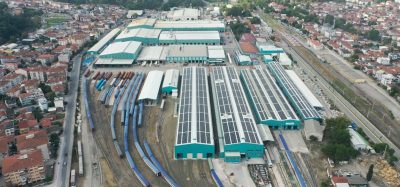Deploying Neopul’s know-how in Dublin
Posted: 10 December 2010 | | No comments yet
This report describes Neopul’s work on the Luas b1-400 extension of the Green Line from the Sandyford depot to Cherrywood industrial estate, which was opened to the public on 16 October 2010.
The green line was the existing connection from Dublin city centre (St. Stephen’s Green Station) and the recent developed Sandyford area with an extension of 9km. The scope of the B1-400 extension developed by Neopul, included the expansion of the existing line with more 7.5km towards the south from the existing Sandyford Stop to Brides Glen. This contract also included the expansion of the Sandyford Depot (2km of single track) in order to cater for the new vehicles.
This report describes Neopul’s work on the Luas b1-400 extension of the Green Line from the Sandyford depot to Cherrywood industrial estate, which was opened to the public on 16 October 2010. The green line was the existing connection from Dublin city centre (St. Stephen’s Green Station) and the recent developed Sandyford area with an extension of 9km. The scope of the B1-400 extension developed by Neopul, included the expansion of the existing line with more 7.5km towards the south from the existing Sandyford Stop to Brides Glen. This contract also included the expansion of the Sandyford Depot (2km of single track) in order to cater for the new vehicles.
This report describes Neopul’s work on the Luas b1-400 extension of the Green Line from the Sandyford depot to Cherrywood industrial estate, which was opened to the public on 16 October 2010.
The green line was the existing connection from Dublin city centre (St. Stephen’s Green Station) and the recent developed Sandyford area with an extension of 9km. The scope of the B1-400 extension developed by Neopul, included the expansion of the existing line with more 7.5km towards the south from the existing Sandyford Stop to Brides Glen. This contract also included the expansion of the Sandyford Depot (2km of single track) in order to cater for the new vehicles.
Neopul’s work scope included the design, construction, testing and commissioning of approximately 17km of single track of light rail line system with 1,435mm gauge.
Join our free webinar: Rail cyber-security in a time of technological and regulatory transformation
Join our expert panel, including speakers from Nokia and Siemens Mobility, to explore the critical convergence of cybersecurity and 5G rail comms.
Date: 3 Dec | Time: 15:00 GMT
Can’t attend live? No worries – register to receive the recording post-event.
Stops
The Luas B1-400 contract included the execution of 11 stops and the extension of the existing Sandyford Stop from 40m to 53m as well as the increase of its platforms from two to three.
All stops were executed in a concrete embedded slab track system with the exception of the referred Sandyford Stop, which was extended with a pre-casted system put on top of the existing ballasted track (Bodan System). Upon casting the panels which formed the system, special care was taken in consideration once there was a signalling loop located on the extended area. On this location, the respective panels not only had to have a recess to cater for the loop, but also the rebar had to be replaced by glass fibre cables to ensure the same strength and durability without compromising or interfering with the loop operation.
The Stops built were Sandyford (existing); Central Park; Glencairn; The Gallops; Leopardstown; Racecourse; Carrickmines; Brennanstown; Laughanstown; Cherrywood and Brides Glen.
Track types
On the materialisation of the track, three different track types were used together with the necessary solutions to cater for the respective transitions, which were:
- Approximately 3,500 linear metres of single ballast track – built with the supply of 10,100 tonnes of calibrated ballast, 4,000 monobloc sleepers with 8,000 Vossloh fastening system type Skl 14, 343 tonnes of vignole S49E1 rails, 12 turnouts with point heating system and special track equipment including twist rails, normal and isolated rail joints and transition rails to allow a perfect transition between the vignole and grooved sections.
- Approximately 8,400 linear metres of single embedded track – built with the supply of 11,000 cubic metres of C40/50 concrete, 1,175 tonnes of rebar, 118 tonnes of rubber encapsulated grooved Ri54 rails and 865 tonnes of encapsulated grooved Ri59 rails, one encapsulated Ri54 grooved rail diamond crossover with point heating system, special track equipment, complete rubber encapsulation of all the system, 12 pairs of encapsulated grooved Ri54 expansion joints, embedded transversal and longitudinal drainage and a system for derailment prevention on the structures (bridges and tunnels) – tram arresting devices.
- Approximately 3,200 linear metres of single plinth track – built with the supply of 1,200 cubic metres of concrete, 91 tonnes of rebar, 314 tonnes of vignole S49E1 rails, 12 pairs of vignole rail bridge expansion joints, 10,000 Vossloh fastening systems type 336 and special track equipment including twist rails, normal and isolated rail joints and transition rails to allow a perfect transition between the vignole and grooved sections
- Approximately 1,800 linear metres of single ballast track inside the Sandyford Depot to increase the number of stabling lines – built with the supply of 7,000 tonnes of calibrated ballast, 2,000 monobloc sleepers with 4,000 Vossloh fastening system type Skl 14, 177 tonnes of vignole S49E1 rails, 10 turnouts with point heating system and special track equipment including twist rails, expansion joints and normal and isolated rail joints
- Approximately 2,500 aluminothermic weldings including ultrasonic testing of every single one.
Track work description
The ballasted track was built essentially in areas separated from the urban regions, whilst the embedded track was built in areas shared with the traffic (road crossings) and in urbanised areas or where urbanisation is planned. The plinth track was installed over concrete structures (viaducts and bridges) constructed in previous contracts.
The ballasted track was positioned and levelled thanks to rail road excavators equipped with two independent tamping heads with variable depth and positioning control, able to tamp track and turnout sleepers, together with mechanic rail jigs.
The plinth track was positioned thanks to the use of levelling jigs and alignment push pull props, whilst on the embedded track a pre mounted sacrificial system formed from metallic sleepers and levelling bolts (Rheinfeder System) was used. This system was entirely assembled on a compound built for this purpose, were a covered marquee with an area of 2,500m2 was created to allow gluing the rubber encapsulation to the rails on a controlled environment, before forming the 18m track panels put together with the Rheinfeder system.
Besides the track, there was also the following installed:
- In the vicinity of the Sandyford Stop, one trailing non-motorised switch, three set of motorised facing switches and four sets of non-motorised points set for spring operation to facilitate normal reversing operations at the stop
- On the Sandyford Depot, one trailing nonmotorised switch and nine sets of motorised facing switches operated by the tram drivers
- Two trailing non-motorised switches and a track crossover located between the running lines in the vicinity of The Gallops and The Carrickmines tram stops (two in each) for emergency and occasional operational use
- A set of scissor points in advance of the Brides Glen terminus comprising one set of motorised facing switches and three sets of non-motorised points set for spring operation to facilitate normal reversing operations at the stop.
On the Cherrywood viaduct on the track terminus, besides the construction and concrete sealing of the track, Neopul also applied imprinted black concrete on the surface, white on the walkways.
The track crossed the following structures:
- Brewery Road Viaduct – over the Brewery Road roundabout
- Leopardstown Viaduct – over the M50 Highway
- Carrickmines Viaduct – over the M50 Highway
- Glenamuck Underpass – under Glenamuck Road
- Spine Road Tunel – under a future development area
- Cherrywood Viaduct – over the R118 Road.
Due to the low temperatures during the Irish winter, point heating systems were installed in all turnouts except on the emergency diagonals, in order to defrost the points whenever necessary.
In order to overcome the longitudinal movements imposed by the joints between the land and the structures, 24 expansion joints were supplied and applied.
All rail profiles were joined with aluminothermic weldings and every single one was tested ultrasonically.
Tension releasing was performed to all non embedded track.
At the end of the construction but before gauge run, preventive grinding was applied to the entire line.
OCS
Regarding the OCS system and under this contract, Neopul constructed the complete Overhead Conductor System to be operated at a nominal tension of 750 Vcc on the complete 17km of single track including OCS poles (lateral & axis), bracket arms, cross span and stitches, pole tensioning equipment/mechanism, wall fixings and building anchors, overhead line equipment including conductor and feeder system including the connection to the OCS.
On the Sandyford Depot, Neopul also constructed the Overhead Conductor System sectioning, including splitting the OCS power feeding the PIT and SLAB lanes into two separate sections per lane and all necessary changes to integrate the new system to the old one including Poles, suspensions (GRP bracketarms), anchoring, section insulators and contact wire.
Besides the overhead, Neopul’s scope also included the materialisation of the feeder cables and return traction along all the track extension, including Trackside Distribution Cabinets and Track Disconnector Switches ensuring a perfect interface with the existing Luas system.
All work was done ensuring the compatibility, interoperability of the tram services with existing Luas infrastructure and according with the maintenance requirements.
About the Author
Paulo Jorge Ribeiro Corte Real de Oliveira
Paulo Jorge Ribeiro Corte Real de Oliveira has a Degree in Civil Engineering which he achieved from the Faculdade de Engenharia da Universidade do Porto. Since May 2007 until August 2010, he was Neopul’s Project Manager of the design and build of track and overhead conductor system of the recently opened Luas Green Line extension from Sandyford to Cherrywood.
Global Railway Review Autumn/ Winter Issue 2025
Welcome to 2025’s Autumn/ Winter issue of Global Railway Review!
The dynamism of our sector has never been more apparent, driven by technological leaps, evolving societal demands, and an urgent global imperative for sustainable solutions.
>>> Read the issue in full now! <<<








